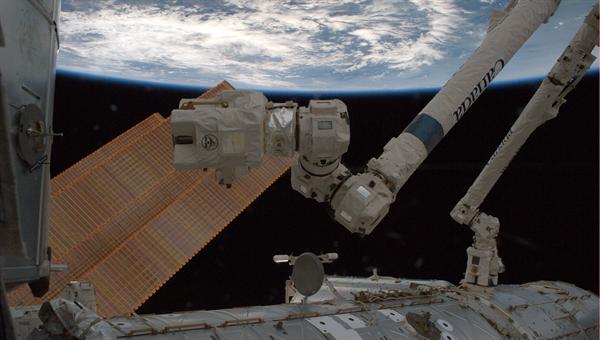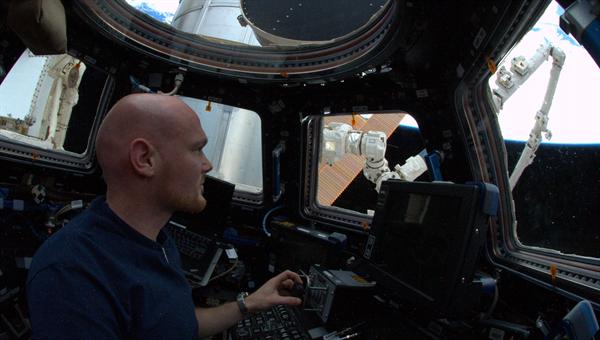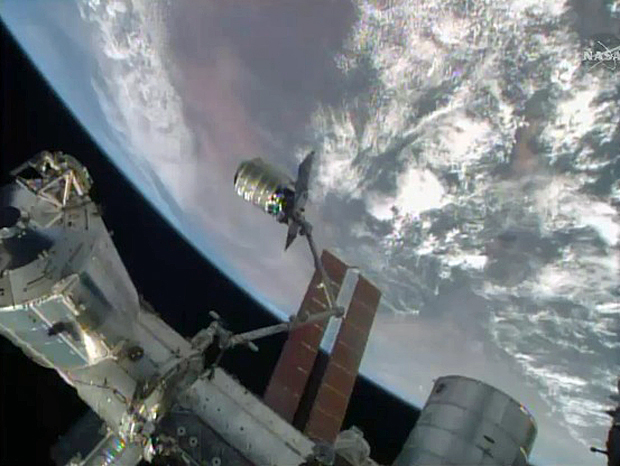.
15.07.2014

Choreographie mit dem Roboterarm der ISS

Bis auf zwölf Meter nähert sich am 16. Juli 2014 um 12.39 Uhr mitteleuropäischer Zeit das Transportfahrzeug Cygnus Orbital-2 der Internationalen Raumstation ISS - und dann muss Astronaut Alexander Gerst gemeinsam mit seinem Kollegen Steve Swanson dafür sorgen, dass der Transporter sicher eingefangen und an die Raumstation angedockt wird. Während Swanson den Roboterarm bedient, wird Gerst unter anderem die Kameras am Roboterarm steuern. Trainiert hat der deutsche ESA-Astronaut dieses Manöver bereits vor seinem Start ins All sowie in der vergangenen Woche an Bord der ISS. "Da gibt es eine ausgeklügelte Choreographie, der das Team folgt", sagt Astronautentrainer Norbert Illmer vom Deutschen Zentrum für Luft- und Raumfahrt (DLR).
"Wie eine Kobra vor ihrer Beute", beschreibt Alexander Gerst den über 17 Meter langen Roboterarm "Canadarm-2", der sich mit sieben Gelenken an der Außenseite der ISS entlangbewegen kann. Wenn der Orbiter, der am 13. Juli 2014 um 18.52 Uhr mitteleuropäischer Zeit zur ISS startete, ankommt, werden Alexander Gerst und Steve Swanson in der Aussichtskuppel Cupola bereit sein. "Alexander Gerst wird bei diesem Einfangmanöver die Assistentenrolle einnehmen und dem Operator Swanson den Rücken frei halten", sagt Astronautentrainer Illmer. Trainiert sind beide Astronauten für beide Funktionen - und könnten bei Bedarf jederzeit die Rollen tauschen.
Bevor der Roboterarm zugreifen kann, muss Gerst kontrollieren, dass sowohl die Raumstation als auch der Transporter frei und ohne Antriebsstöße schweben. Erst dann kann Swanson den Roboterarm steuern und das Raumschiff greifen. Damit er dabei die beste Sicht auf das Geschehen außerhalb der ISS hat, wird sein Assistent Alexander Gerst beispielsweise Blickwinkel und Zoom der Kameras an die jeweilige Situation anpassen. "Swanson konzentriert sich auf die Steuerung, Alexander muss das Gesamtbild im Auge haben", erläutert Illmer. "Ohne diese Teamarbeit kann dieses Manöver nicht durchgeführt werden." 20 Minuten dauert diese "heiße" Phase, in der der Transporter mit dem Roboterarm erfasst wird. Nach einem anschließenden Check in den nächsten ein, zwei Stunden wird Cygnus Orbital-2 dann an dem amerikanischen Verbindungsknoten "Harmony" der ISS angebracht.
Ausrüstung, Experimente und Essen
Die Verbindungsluke zwischen Raumstation und Transporter wird einen Tag später geöffnet. Fast 1500 Kilogramm Fracht bringt der Transporter zur ISS mit. Dazu gehören neben einem Schwarm kleiner Satelliten, so genannten CubeSats, auch verschiedene amerikanische Studentenexperimente, Material für die Raumstation sowie Ausrüstung für Weltraumausstiege. Die Astronauten dürften sich vor allem auf die 764,2 Kilogramm Essen, Versorgung und Crew-Pakete freuen, die ebenfalls mit Cygnus Orbital-2 ankommen. Seinen Rückflug tritt der Transporter in etwa einem Monat an, um dann gefüllt mit Abfällen über dem Südpazifik wieder in die Atmosphäre einzutreten.
Beteiligt ist der deutsche Astronaut Alexander Gerst auch bei der Ankunft des europäischen Raumtransporters ATV-5 voraussichtlich am 12. August 2014, wenn er das automatische Andocken überwachen und gegebenenfalls stoppen muss. Dann werden 6500 Kilogramm Fracht - darunter auch ein Schmelzofen (Elektromagnetische Levitator; EML) für materialwissenschaftliche Untersuchungen - die ISS erreichen.
Quelle: DLR
.
Update: 17.07.2014
-
Cygnus cargo ship berthed at station
.

Against the backdrop of planet Earth, the International Space Station's robot arm locked onto a Cygnus cargo ship Wednesday and pulled it in for berthing to close out a near-flawless three-day rendezvous. (Credit: NASA TV)
.
A Cygnus cargo ship loaded with more than 1.5 tons of supplies and equipment was plucked out of open space by the International Space Station's robot arm early Wednesday and pulled in for berthing to wrap up a three-day rendezvous.
With the cargo craft holding position about 30 feet away, Expedition 40 commander Steve Swanson, operating the Canadian-built robot arm, locked onto a grapple fixture on the bottom deck of the Orbital Sciences-built spacecraft at 6:36 a.m. EDT (GMT-4) as the two spacecraft sailed 260 miles above northern Libya.
"Houston and station, we now have a seventh crew member," Swanson radioed. "Janice Voss is now part of Expedition 40."
Voss, a five-flight shuttle veteran who worked for Orbital Sciences before joining NASA, died in 2012. The company named the Cygnus cargo ship in her honor.
"Janice devoted her life to space and accomplished many wonderful things at NASA and Orbital Sciences, including five shuttle missions," Swanson said. "And today, Janice's legacy in space continues. Welcome aboard the ISS, Janice."
Flight controllers at the Johnson Space Center in Houston then took over, operating the robot arm by remote control to slowly pull the Cygnus cargo craft in for berthing at the Earth-facing port of the forward Harmony module. Once in position, motorized bolts drove home to firmly lock the craft to the docking port.
"The mechanical systems officer here in mission control reports a good second stage capture," said NASA commentator Rob Navias. "And so at 7:53 a.m. Central time, a little over two hours after it was grappled in open space by Steve Swanson, the Expedition 40 commander, Cygnus is now hard mated to the International Space Station's Harmony module, a fixture for the station for the next four weeks."
After opening hatches between the spacecraft, the station crew will begin the process of unloading some 3,300 pounds of food, clothing, research equipment, spare parts and other gear, including 32 small "nanosat" satellites that will be released from the lab later. Twenty eight of those were provided by Planet Labs in a commercial venture to develop low-cost Earth imagery.
The grapple and berthing operation wrapped up a textbook rendezvous that began with launch of an Orbital Sciences Antares rocket Sunday from the Mid-Atlantic Regional Spaceport at NASA's Wallops Island, Va., flight facility. The Cygnus cargo craft carried out a series of carefully timed thruster firings to catch up with the station, reaching the lab complex early Wednesday and then standing by while Swanson locked on with the robot arm.
Once unloaded, the Cygnus will be packed with trash and no-longer-needed gear before unberthing on Aug. 15. After leaving the vicinity of the station, Orbital engineers plan to test new rendezvous equipment before the cargo ship re-enters the atmosphere and burns up.
The Cygnus is the first of four cargo ships expected to arrive over the next two months. A Russian Progress supply ship is scheduled for launch July 23, followed one day later by the European Space Agency's fifth and final Automated Transfer Vehicle. The ATV will arrive at the station Aug. 12. One month after that, a SpaceX Dragon cargo ship is scheduled for launch from Cape Canaveral, arriving at the station two days later.
In the midst of the cargo traffic, the station crew plans to carry out three spacewalks, with a Russian excursion by Alexander Skvortsov and Oleg Artemyev planned for Aug. 18 and two NASA EVAs on Aug. 21 and 29. Swanson and Reid Wiseman will carry out the first U.S. EVA while Wiseman and European Space Agency astronaut Alexander Gerst will carry out the second.
Swanson, Skvortsov and Artemyev plan to undock and return to Earth aboard their Soyuz TMA-12M ferry craft Sept. 11. Three fresh crew members -- Soyuz TMA-14M commander Alexander Samokutyaev, Barry Wilmore and Elena Serova -- are scheduled for launch from the Baikonur Cosmodrome in Kazakhstan on Sept. 25.
Quelle: CBS
4715 Views
